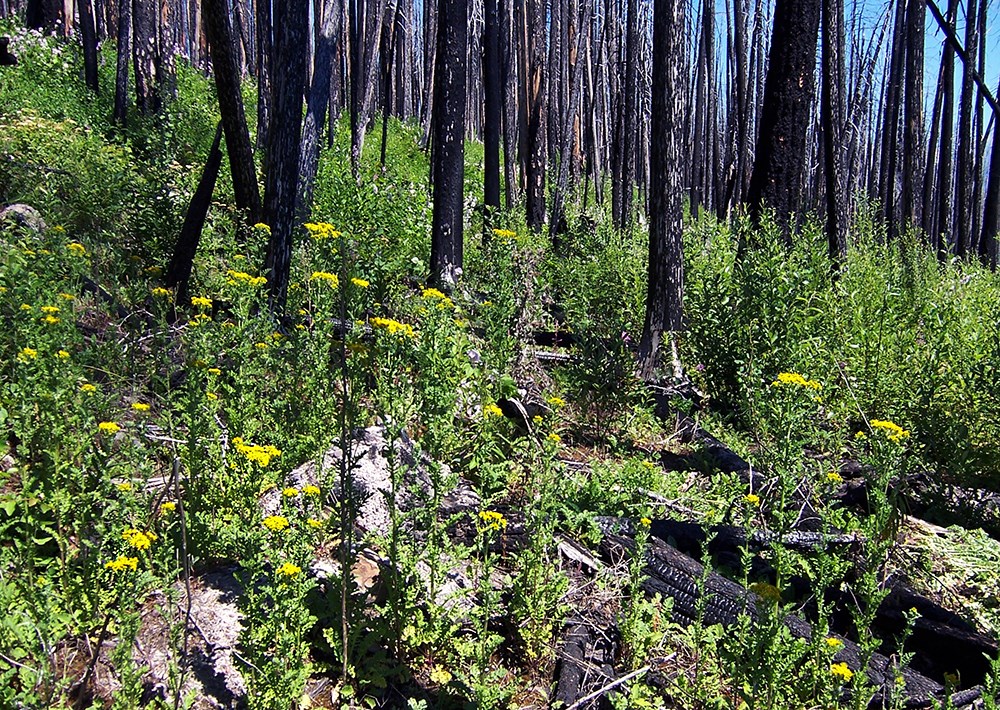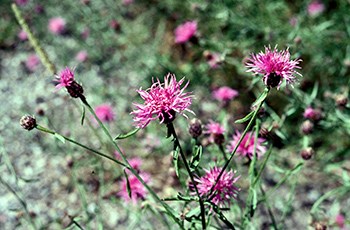Last updated: October 14, 2024
Article
Fire and Invasive Weeds Resource Brief
Background Information

NPS
Threats
Noxious weeds pose a threat for several reasons, including their ability to quickly reproduce after a disturbance and outcompete native plants for resources. If an invasive species takes hold, it may dominate water, nutrients, and space, preventing native species from re-establishing. This can lead to a plant community which is dominated by a single invasive species, providing inadequate forage for wildlife. Over time, these factors can degrade the health and biological diversity of an ecosystem. Even if an area was previously uncontaminated by invasive weeds, firefighters can bring in seeds on their clothing, boots, vehicles, and equipment during the course of their work. Recently burned areas provide the ideal environment for invasive plants to thrive, making them especially vulnerable to the introduction of seeds. With fire predicted to threaten Glacier more frequently, there is an increased likelihood of invasive seeds being introduced into remote areas.
Wildfire is an integral component of a healthy forest. Without it, forests lose their diversity, nutrients remain locked away in dead plant material, and important wildlife habitat and food sources are lost. Yet, even though fire offers many benefits, it also creates unwanted consequences. One of these is the invasion of unwanted exotic plants. These plants, also known as invasive or noxious weeds, are non-native species that can reproduce quickly and often outcompete native plants for water, nutrients, and space. If left unchecked, invasive weeds can displace intact, healthy native plant communities and ultimately have a significant negative impact on the wellbeing of an entire ecosystem.
Disturbed areas, including recently burned forests and grasslands, create ideal environments for invasive plants. Native species are temporarily removed from the ecosystem, creating less competition for noxious weeds and giving them an opportunity to take hold. Native plants also tend to be slow to regenerate after a disturbance, lying dormant and not producing seeds until the following season. In contrast, many invasive species produce seeds continually throughout the growing season. Invasive plants have an additional advantage, in that none of their natural predators or diseases are present, exposing them to fewer stressors than native plants. The result – noxious weeds which can re-sprout, flower, and set seeds within six weeks of a fire. Consequently, the spread of invasives after a fire is a major concern for park biologists and fire managers.
Status and Trends
There are currently 129 non-native plant species in Glacier National Park, 28 of which are considered noxious weeds. These plants have come into the park over a long period of time, in many cases prior to a defined plant management plan. Some, such as oxeye daisy, were introduced intentionally as ornamentals, while others were unintentionally brought in by people, animals, machinery, or wind. Since 2006 alone, four more species of noxious weeds have been documented in Glacier. So far these infestations have been detected early and are under control, but their spread illustrates the difficulties of managing invasive species in a park visited by millions of people from across the globe.
The predicted effects of a warming climate include hotter, more frequent wildfires and longer fire seasons. This trend may result in more intense fires in the backcountry and consequently more opportunities for new invasive plant infestations to become established in remote, recently burned areas.
Decontaminating firefighting equipment and people before they enter or leave a burn site decreases the risk of introducing invasive seeds. When possible, Glacier fire crews use equipment exclusively from the park’s cache, eliminating the need to decontaminate equipment between fires. If other equipment is brought in, or Glacier equipment is used outside of the park, it is pressure washed to prevent the transfer of seeds. Although invasive plants are not a fire crew’s first priority, with planning, decontamination, and a careful crew, the spread of weeds after a fire can be minimized.

NPS
Management Strategy
Approaches to controlling invasive plants after a fire can range from aggressive removal of weeds followed by reintroduction of native species, to non-aggressive, natural revegetation. Glacier follows a strategy of noninterference whenever possible. If kept clear of invasive seeds, a recently burned area will regenerate on its own and native plants will re-establish. Biologists and fire managers monitor areas where invasive plants were known to occur before a fire, or where it is suspected that seeds were introduced. If an infestation is discovered, weeds are removed by hand-pulling or with the use of herbicides, when appropriate. This management policy allows infestations to be treated individually, resulting in a minimally aggressive strategy. However, as fires become larger and more frequent, and invasive seeds are introduced further into the backcountry, aggressive measures may become the norm instead of the exception.
Prevention is arguably the most effective method of stopping the spread of invasive plants. At Glacier, prevention measures include prohibiting hay and requiring weed seed free pellets for livestock; mandatory inspections of boats for invasive aquatic plant and animal species; and a citizen science program which teaches visitors and staff to identify and report invasive weeds. The ecological degradation that invasive weeds cause can be avoided altogether by preventing seeds from being introduced into new areas and quickly suppressing infestations that do occur.
Resources for More Information
Glacier National Park Staff
- Dawn LaFleur, Integrated Pest Management and Restoration Biologist
- Dave Soleim, Fire Management Officer
Documents and web sites
- Invasive Plants of the Crown of the Continent Field Guide – www.crownmanagers.org/publications
- US Fish and Wildlife Service “Fire Management and Invasive Plants: A Handbook” – www.fws.gov/invasives/pdfs/USFWS_FireMgtAndInvasivesPlants_A_Handbook.pdf
- US Forest Service Fire Effects Information System – https://www.feis-crs.org/feis/
- Center for Invasive Species Management – www.weedcenter.org
The Crown of the Continent Research Learning Center
Phone: 406-888-5827; Email: melissa_sladek@nps.gov
Website: www.nps.gov/rlc/crown
